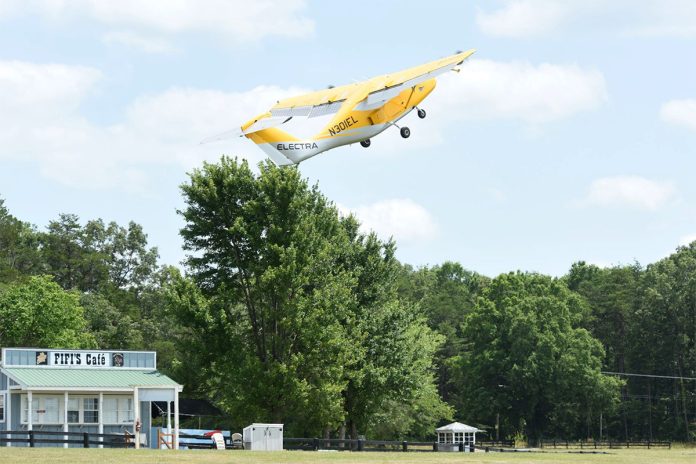Electra has made significant strides in the aviation industry with its innovative hybrid-electric short takeoff and landing (eSTOL) aircraft. Last month, the company successfully completed a series of test flights from a grass field, marking a significant milestone in its development. The test flights showcased the aircraft’s ability to take off from a field smaller than 300 feet, demonstrating the potential for operations in a variety of unconventional locations.
The aircraft in question, the EL-2 Goldfinch, first took to the skies in May. This latest test involved taking off from a grassy area near Electra’s facility in Manassas, Virginia. The successful test flights are a testament to the company’s advanced technology and engineering prowess.
Electra’s eSTOL aircraft is designed to operate from soccer field-sized spaces, making it a versatile option for various applications. The aircraft’s blown lift propulsion system enables it to achieve lift-off at neighborhood driving speeds. This propulsion system guides airflows over the wing into flaps and ailerons, redirecting them toward the ground and enhancing thrust from the aircraft’s eight electric motors.
The aircraft’s performance during the test flights was impressive. It completed several takeoffs and landings, climbing at a steep angle of 32 degrees. Unlike many electric vertical takeoff and landing (eVTOL) air taxis, the Goldfinch does not require electric charging infrastructure. Instead, its propulsion unit charges the batteries in flight, providing greater operational flexibility.
One of the most remarkable aspects of the Goldfinch’s performance is its noise level. During flight, the aircraft produced just 55 decibels of noise, equivalent to the volume of a typical conversation, when flying overhead at 500 feet. Electra claims that its full-scale design, capable of carrying nine passengers or up to 2,500 pounds of cargo on trips up to 500 statute miles (434 nautical miles), will be inaudible from the ground at its typical cruise altitude.
Electra aims to certify a full-scale model of the eSTOL aircraft under FAA Part 23 regulations by 2028. The company’s vision is to increase the number of available landing sites significantly compared to traditional fixed-wing aircraft, while also offering higher cruise speeds, lower costs, and reduced noise levels compared to vertical lift solutions.
JP Stewart, vice president and general manager of Electra, expressed the company’s excitement about the test flights. “These first flights from a field demonstrate the beginnings of this strong capability that we will continue to develop,” he said. “eSTOL technologies increase the number of available landing sites by orders of magnitude relative to traditional fixed-wing aircraft while providing for higher cruise speeds, lower costs, and lower noise than vertical lift solutions.”
Electra’s eSTOL aircraft has garnered interest from various sectors, including the military. The company has multimillion-dollar contracts with the Air Force, Army, and Navy, all of which are exploring the use of eSTOL technology. The military sees the relatively inexpensive, runway-independent aircraft as an attractive alternative to conventional fixed-wing aircraft and rotorcraft. The eSTOL’s ability to operate from dispersed locations aligns with the U.S. Air Force’s agile combat employment doctrine, which emphasizes the rapid deployment of assets.
In addition to its military applications, Electra’s eSTOL aircraft has attracted attention from commercial customers. The company surpassed 2,000 aircraft preorders from private partners, including JSX, Bristow Group, and JetSetGo, as of January. Electra envisions its eSTOL aircraft being used for a variety of purposes, from airlift operations to commercial air travel.
Source: Electra.Aero



